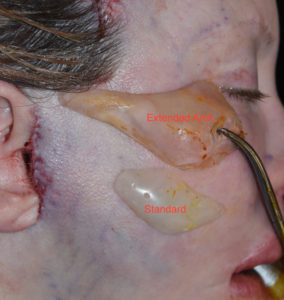The zygomatic arch is the thin section of bone that connects the main body of the cheek (zygoma) with that of the skull. (temporal skull) Thus it is formed by the zygomatic process of the temporal bone that comes forward to meet with the temporal process of the cheekbone. They meet in the middle to form the zygomaticotemporal suture. Underneath the arch passes the temporalis muscle which attaches to the lower jaw. Attached to the arch itself is the origin of the masseter muscle. Between the temporalis and masseter muscles the zygomatic arch plays a useful role in opening and closing ones mouth as well as chewing.
The zygomatic arch also has a useful role in facial aesthetics. High cheekbones are a sought after facial shape in both men and women as commonly seen in many models of all genders. This is where the cheeks jut out and create a visible line back along the sides of the face. In reality this is caused more by having prominent zygomatic arches than a large cheekbone or zygoma proper. (although the two usually occur together)
The importance of the zygomatic arch in the shape of most standard cheek implants do not factor this important anatomic aesthetic component, Many patients seek to have this cheek augmentation look but often end up disappointed because the cheek implant chosen could not create an extended arch effect or the high cheekbone look.

Placement of extended cheek implants is done in the identical fashion as standard implants through an intraoral approach. The subperiosteal dissection is done further back along the zygomatic arch. The narrowing of the arch as it extends posteriorly, its curved surface which dips down toward the ear and longitudinal length of the implant requires a meticulous pocket dissection to avoid implant alignment and asymmetry issues.
Dr. Barry Eppley
Indianapolis, Indiana


